Are you curious about the local attitudes towards different religions coexisting in Southeast Asia and how they impact your travel experiences? At SIXT.VN, we provide insights into this topic, helping you navigate cultural landscapes with respect and understanding, ensuring a richer and more meaningful journey through Vietnam and beyond. This knowledge helps improve community relations, cultural sensitivity, and understanding of religious harmony.
1. How Do Southeast Asian Countries Generally View Religious Diversity?
Most Southeast Asian countries generally view religious diversity positively. According to a Pew Research Center study, many people express acceptance of religious diversity, with majorities willing to accept followers of other religions as neighbors. This widespread tolerance creates a welcoming environment for tourists interested in exploring the region’s diverse cultures and faiths.
The positive view of religious diversity in Southeast Asia translates to a more inclusive and harmonious society. For travelers, this means:
- Greater Cultural Immersion: You’ll find it easier to engage with locals from different religious backgrounds, gaining deeper insights into their traditions and beliefs.
- Enhanced Travel Experiences: Religious sites and cultural festivals are often celebrated openly, allowing you to participate and learn firsthand about the region’s spiritual heritage.
- Safer and More Respectful Travel: Understanding the local attitudes towards religion helps you avoid unintentional cultural faux pas and ensures respectful interactions.
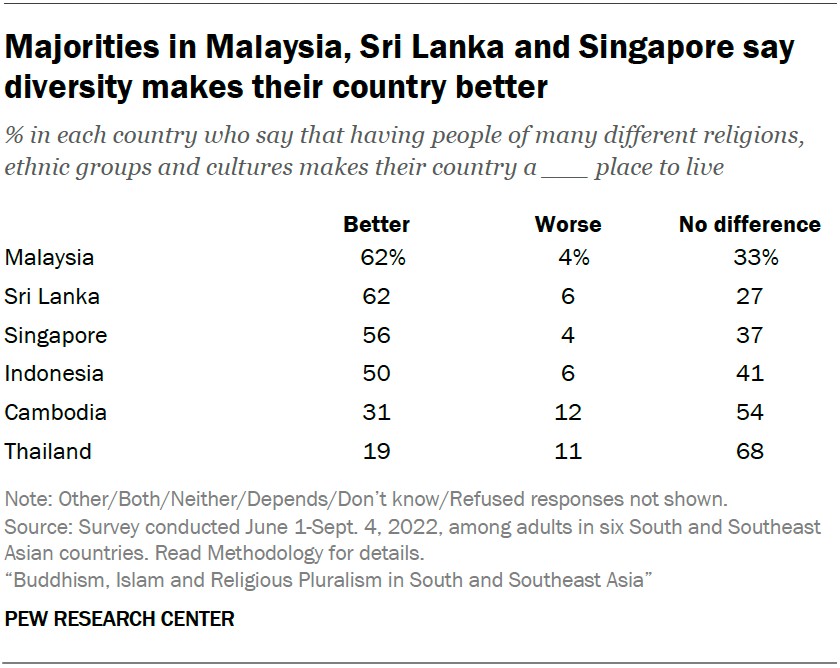 People in Malaysia, Sri Lanka and Singapore say diversity makes their country better
People in Malaysia, Sri Lanka and Singapore say diversity makes their country better
2. Which Countries Are Most Open to Religious Diversity?
Malaysia, Sri Lanka, and Singapore are among the most open to religious diversity. Majorities in these countries believe that having people from different backgrounds makes their country a better place to live. This openness is reflected in their inclusive policies and vibrant multicultural societies, making them ideal destinations for travelers seeking diverse cultural experiences.
Here’s a breakdown of what makes these countries stand out:
- Malaysia: Known for its harmonious blend of Malay, Chinese, Indian, and indigenous cultures, Malaysia celebrates religious festivals from various faiths, creating a vibrant and inclusive atmosphere.
- Sri Lanka: Despite past conflicts, Sri Lanka showcases a remarkable level of religious tolerance, with strong interfaith relations and mutual respect among Buddhists, Hindus, Muslims, and Christians.
- Singapore: As a global hub, Singapore embraces diversity as a core value, fostering a society where different religions coexist peacefully and contribute to the country’s unique identity.
These attitudes enhance tourism by:
- Promoting Cultural Tourism: Visitors are drawn to these countries to witness and learn about the harmonious coexistence of different faiths.
- Encouraging Interfaith Dialogue: The open environment fosters discussions and understanding between people of different religions, both locals and tourists.
- Creating Positive Travel Experiences: Travelers feel welcome and respected, leading to more fulfilling and memorable trips.
3. Are There Any Contrasting Views on Religious Diversity?
Yes, while most Southeast Asian countries support religious coexistence, some harbor strong nationalist sentiments. Many believe their culture is superior to others and that being born in their country and belonging to the dominant ethnic or religious group is crucial to national identity. These views can sometimes lead to tensions but are generally balanced by the overall acceptance of diversity.
The coexistence of tolerance and nationalism can manifest in several ways:
- Cultural Preservation: While embracing diversity, there’s also a strong emphasis on preserving traditional cultures and values, which can sometimes lead to cultural gatekeeping.
- Religious Identity: Some individuals may feel that adhering to the dominant religion is essential for national identity, which can create challenges for minority religious groups.
- Navigating Cultural Sensitivities: Tourists need to be mindful of these sentiments and respect local customs and traditions to avoid unintentional offenses.
For tourists, this means:
- Respecting Local Customs: Learning about the local culture and etiquette is crucial to avoid misunderstandings.
- Being Mindful of Religious Practices: Observing and respecting religious practices, especially in sacred sites, is essential.
- Engaging in Cultural Exchange: Participating in cultural activities and interacting with locals can foster mutual understanding and appreciation.
4. How Does Education Level Affect Views on Religious Tolerance?
Higher education levels generally correlate with more tolerant views on religious diversity. Educated individuals are more likely to view other religions as peaceful and compatible with their national culture. This suggests that education plays a crucial role in fostering understanding and acceptance of different faiths, leading to more harmonious societies.
Education’s impact on religious tolerance can be seen in:
- Increased Awareness: Higher education exposes individuals to diverse perspectives and promotes critical thinking about different cultures and beliefs.
- Reduced Prejudice: Education helps dispel stereotypes and prejudices, fostering empathy and understanding towards other religious groups.
- Greater Social Cohesion: A more educated population is better equipped to engage in constructive dialogue and build bridges between different communities.
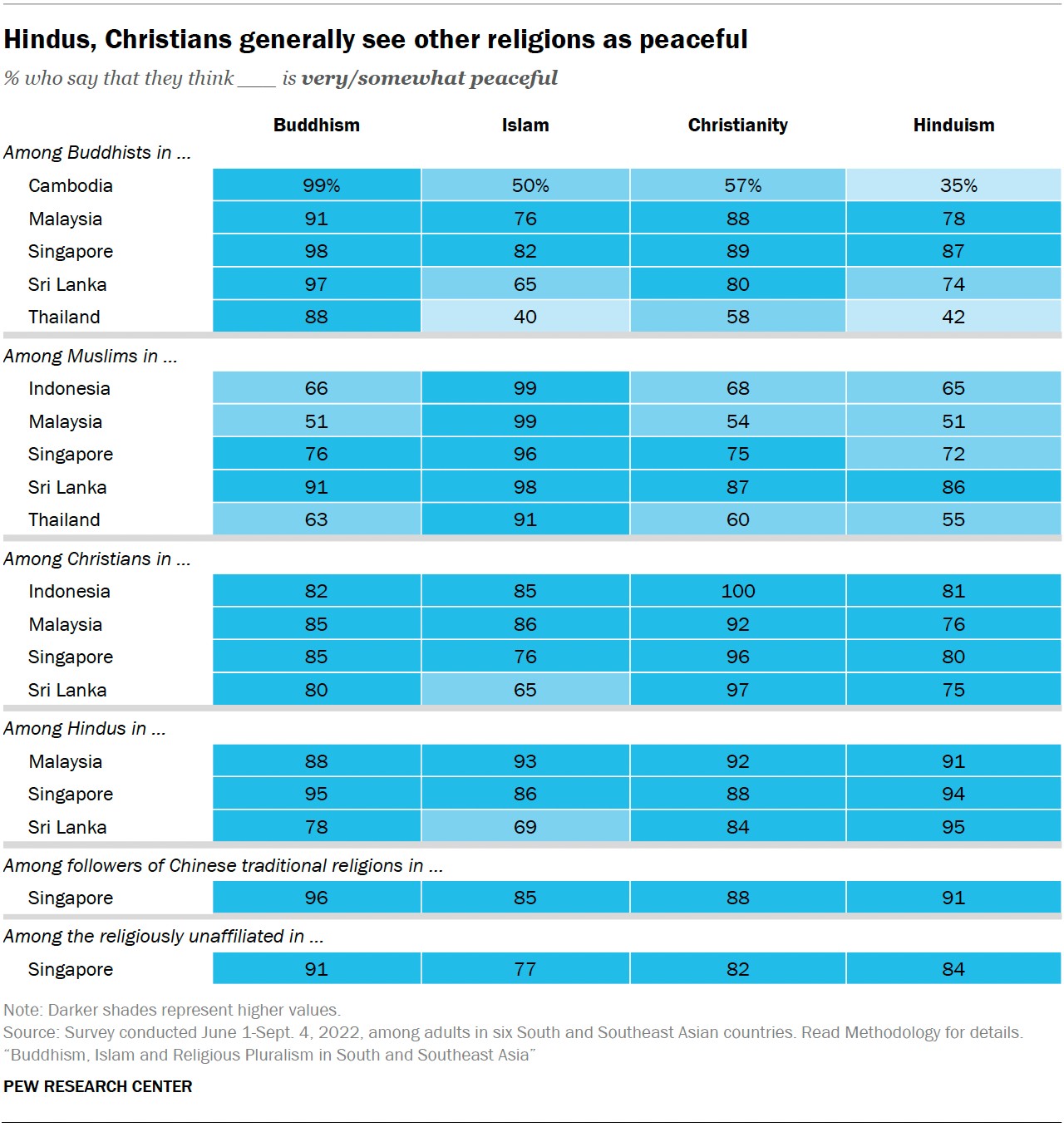 Hindus and Christians generally see other religions as peaceful
Hindus and Christians generally see other religions as peaceful
5. Are There Differences in How Religions View Each Other?
Yes, there are differences in how religions view each other in Southeast Asia. Hindus and Christians are generally more likely to view other religions as peaceful, while Muslims are sometimes less likely to do so. However, clear majorities of Muslims in most countries still view other religions as peaceful, demonstrating a general trend of acceptance and coexistence.
These varying perceptions can influence:
- Interfaith Relations: The level of mutual respect and understanding between different religious communities.
- Social Harmony: The overall atmosphere of peace and cooperation within society.
- Personal Interactions: How individuals from different religious backgrounds interact with each other on a daily basis.
For tourists, this means:
- Being Aware of Potential Biases: Understanding that some religious groups may hold different views about others.
- Promoting Interfaith Dialogue: Engaging in respectful conversations with people from different faiths to learn about their perspectives.
- Supporting Interfaith Initiatives: Contributing to organizations that promote understanding and cooperation between religious communities.
6. What Role Does Age Play in Attitudes Towards Religious Diversity?
Younger adults (ages 18 to 34) are generally more willing than older people to accept members of other groups as neighbors. This suggests that as societies evolve, younger generations are becoming more open-minded and accepting of religious diversity, which bodes well for the future of interfaith relations in the region.
The generational differences can be attributed to:
- Exposure to Diversity: Younger generations are often more exposed to diverse cultures and religions through education, travel, and media.
- Changing Social Norms: Social attitudes towards diversity are evolving, with younger generations more likely to embrace inclusivity.
- Global Connectivity: Increased global connectivity allows younger people to interact with individuals from different backgrounds, fostering understanding and empathy.
This trend impacts tourism by:
- Creating a More Welcoming Environment: Younger locals are more likely to be open and accepting of tourists from different religious backgrounds.
- Promoting Sustainable Tourism: Younger generations are often more aware of the importance of responsible and respectful tourism practices.
- Encouraging Cultural Exchange: Younger locals are more likely to engage in cultural exchange with tourists, leading to more enriching travel experiences.
7. How Do Views on Religious Diversity Vary by Gender?
Men are generally more likely than women to say they would accept members of other religious groups as neighbors. This difference may be due to various social and cultural factors, but it highlights the importance of promoting inclusivity and tolerance among all genders to ensure harmonious coexistence.
The gender differences might stem from:
- Social Roles: Traditional gender roles can influence attitudes towards diversity, with men sometimes having more exposure to different cultures.
- Education and Empowerment: Access to education and empowerment opportunities can impact women’s views on religious tolerance.
- Cultural Norms: Cultural norms and expectations can shape how men and women perceive and interact with different religious groups.
For tourists, this means:
- Being Aware of Gender Dynamics: Understanding how gender roles and attitudes might influence interactions with locals.
- Respecting Cultural Norms: Being mindful of cultural norms regarding gender relations and dressing appropriately.
- Supporting Women’s Empowerment: Contributing to organizations that promote women’s education and empowerment in the region.
8. Are There Any Specific Religions That Face More Scrutiny?
Yes, in some instances, certain religions face more scrutiny than others. For example, a substantial share of Thai Buddhists view Islam as not peaceful, while a similar share of Thai Muslims say the same about Buddhism. These perceptions can lead to tensions and misunderstandings, highlighting the need for interfaith dialogue and education.
The scrutiny faced by certain religions can be due to:
- Historical Conflicts: Past conflicts and tensions between religious groups can create lasting prejudices.
- Misinformation and Stereotypes: Negative stereotypes and misinformation can fuel distrust and animosity towards certain religions.
- Political and Social Factors: Political and social factors can influence how different religions are perceived and treated within a country.
This can affect tourism by:
- Creating a Less Welcoming Environment: Tourists belonging to scrutinized religions may experience discrimination or discomfort.
- Limiting Cultural Immersion: Restrictions on religious practices or cultural expressions can limit opportunities for tourists to engage with certain communities.
- Fueling Social Tensions: Religious tensions can spill over into the tourism sector, creating safety concerns and undermining the overall travel experience.
9. How Do Southeast Asians View the Compatibility of Religions With Their Culture?
Majorities in most Southeast Asian countries agree that other religions are compatible with their country’s way of life. Adults in Singapore are the most likely to view several religions as compatible, while Cambodians are the least likely. These views reflect the varying levels of religious tolerance and cultural integration across the region.
The perception of compatibility is influenced by:
- Cultural Values: How well the values and practices of different religions align with the dominant culture.
- Historical Integration: The extent to which different religions have historically coexisted and influenced each other.
- Social Policies: Government policies that promote or hinder religious diversity and integration.
For tourists, this means:
- Understanding Cultural Context: Learning about the cultural values and historical background of different religions in the region.
- Respecting Local Sensibilities: Being mindful of cultural norms and avoiding actions that might be perceived as disrespectful to local traditions.
- Engaging in Cultural Exchange: Participating in cultural activities and interacting with locals to foster mutual understanding and appreciation.
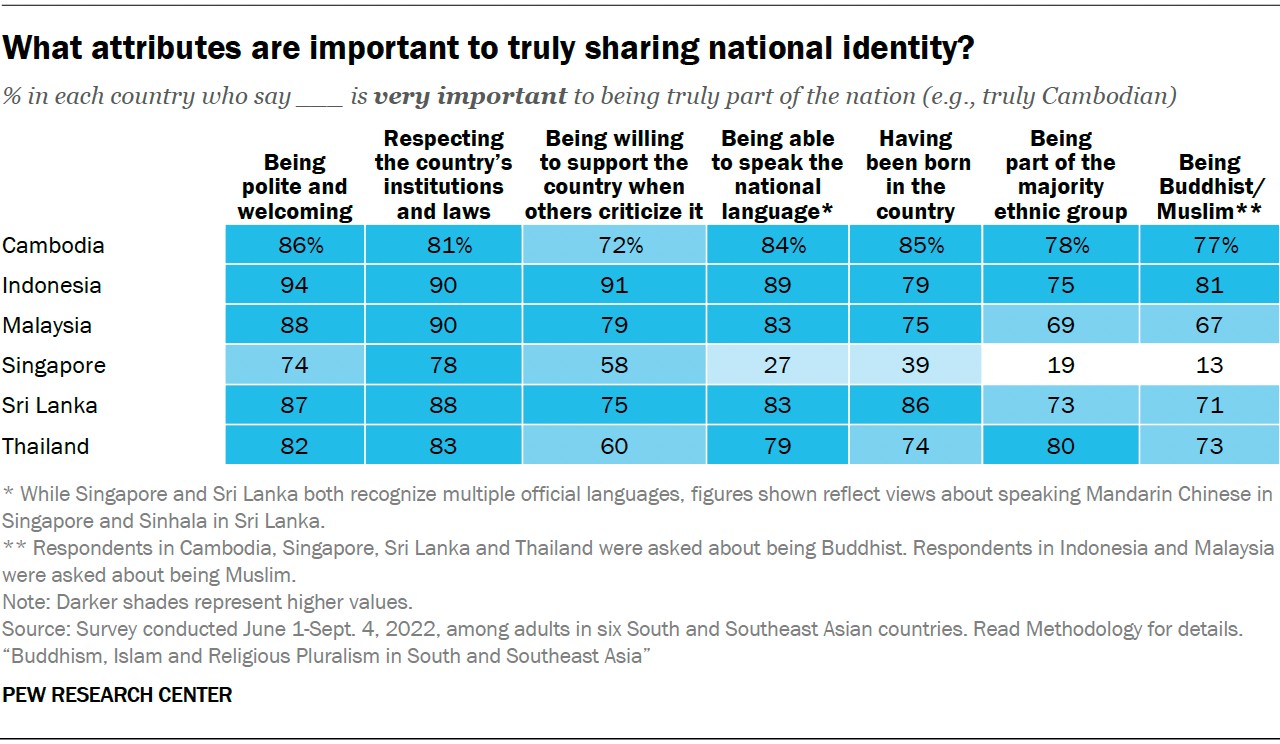 Attributes that are important to truly sharing national identity, by country
Attributes that are important to truly sharing national identity, by country
10. What Are the Key Elements of National Identity in Southeast Asia?
Key elements of national identity in Southeast Asia include values associated with order and intergroup harmony, such as being polite and welcoming, and respecting national institutions and laws. Most people also believe that willingness to support the country when others criticize it is very important to national identity. However, nativist elements like birthplace and membership in the majority ethnic and religious group are also considered important, though less so in Singapore.
These elements shape:
- Social Cohesion: The extent to which people feel connected and united as a nation.
- Cultural Preservation: The emphasis on preserving traditional values and customs.
- National Pride: The sense of pride and belonging that people feel towards their country.
For tourists, this means:
- Respecting National Symbols: Being respectful of national flags, anthems, and other symbols of national identity.
- Adhering to Laws and Regulations: Obeying local laws and regulations, including those related to religious practices.
- Engaging in Responsible Tourism: Practicing responsible tourism by supporting local communities and respecting the environment.
11. Do Southeast Asians Feel Their Culture Is Superior?
Clear majorities in each Southeast Asian country believe their culture is superior to others. This feeling is particularly strong in Cambodia, Sri Lanka, Malaysia, and Indonesia, but less so in Thailand and Singapore. Those who say religion is very important in their lives are more likely to completely agree that their culture is superior to others.
This sense of cultural superiority can influence:
- Attitudes Towards Outsiders: How locals perceive and interact with tourists and foreigners from different cultures.
- Cultural Exchange: The willingness to engage in cultural exchange and learn from other cultures.
- Social Hierarchy: The perceived ranking of different cultures and the potential for discrimination or prejudice.
For tourists, this means:
- Being Humble and Respectful: Approaching local cultures with humility and respect, avoiding arrogance or condescension.
- Learning About Local Customs: Familiarizing yourself with local customs and traditions to avoid unintentional offenses.
- Engaging in Meaningful Interactions: Seeking opportunities to interact with locals on a personal level and learn about their perspectives.
12. What Are the Views on Violence Based on Political or Religious Beliefs?
In all six Southeast and South Asian countries surveyed, roughly half or more of the public says that using violence against people because of their political beliefs or religion can never be justified. Adults in Cambodia, Sri Lanka, and Singapore are most likely to take this position. However, roughly a quarter of adults in Thailand, Indonesia, and Malaysia say that violence can sometimes or often be justified.
These views reflect:
- Commitment to Peace: The desire for peaceful coexistence and the rejection of violence as a means of resolving conflicts.
- Religious Teachings: The influence of religious teachings that promote non-violence and compassion.
- Social Stability: The recognition that violence can destabilize society and undermine social harmony.
For tourists, this means:
- Avoiding Political Discussions: Refraining from engaging in heated political discussions that could escalate into conflict.
- Respecting Religious Sensibilities: Being mindful of religious sensitivities and avoiding actions that could be perceived as provocative or offensive.
- Promoting Peace and Understanding: Supporting initiatives that promote peace, tolerance, and understanding between different communities.
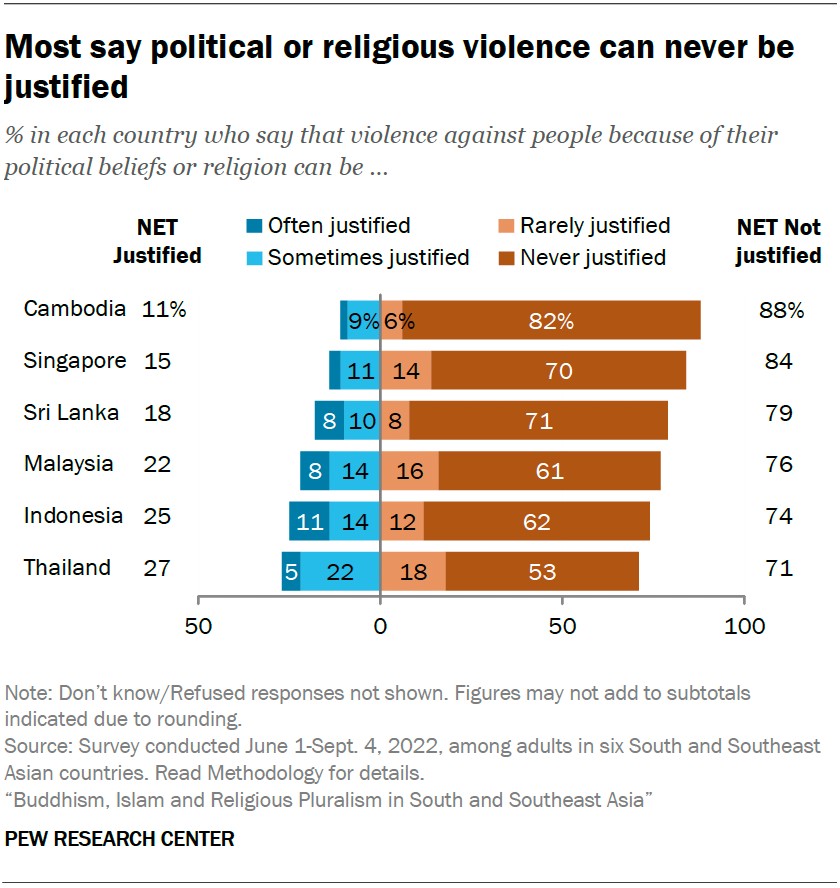 Most say political or religious violence can never be justified
Most say political or religious violence can never be justified
13. What Do Muslims and Buddhists See as Threats to Their Religions?
Muslims and Buddhists are most likely to see extremists from their own faith as a threat. Muslims are generally more likely than Buddhists to say extremists from their own religion are a threat, but in Sri Lanka, Buddhists are much more likely than Muslims to perceive such extremists as a threat. Muslims across the region are generally more likely than Buddhists to perceive the influence of the United States as a threat to their religion.
These perceptions highlight:
- Internal Challenges: The challenges faced by religious communities in dealing with extremism and maintaining their integrity.
- External Influences: The concerns about the impact of foreign powers and ideologies on local religions.
- Social Tensions: The potential for religious extremism and foreign influence to exacerbate social tensions and undermine harmony.
For tourists, this means:
- Being Aware of Extremist Groups: Being aware of the presence and activities of extremist groups in the region.
- Avoiding Association with Extremists: Avoiding any association with individuals or groups that promote violence or intolerance.
- Supporting Moderate Voices: Supporting moderate religious leaders and organizations that promote peace and understanding.
14. What Do Buddhists See as Appropriate for Foreign Non-Buddhists?
Vast majorities of Buddhists say it is appropriate for foreign non-Buddhists to participate in Buddhist practices such as meditation and chanting and to visit Buddhist temples. Similarly large majorities in most countries say that it is appropriate for non-Buddhist foreigners to marry Buddhists from their country. However, Buddhists generally report less support for foreign non-Buddhists adopting Buddhist symbols and images, especially tattoos.
These views reflect:
- Openness to Engagement: The willingness of Buddhists to share their practices and traditions with foreigners.
- Cultural Sensitivity: The importance of respecting Buddhist symbols and images and avoiding actions that could be seen as disrespectful.
- Personal Boundaries: The recognition that certain aspects of Buddhism are reserved for practitioners and should not be appropriated by outsiders.
For tourists, this means:
- Participating Respectfully: Participating in Buddhist practices and visiting temples with respect and reverence.
- Avoiding Appropriation: Avoiding the use of Buddhist symbols and images in ways that could be seen as disrespectful or trivializing.
- Seeking Guidance: Seeking guidance from local Buddhists on appropriate behavior and etiquette in religious settings.
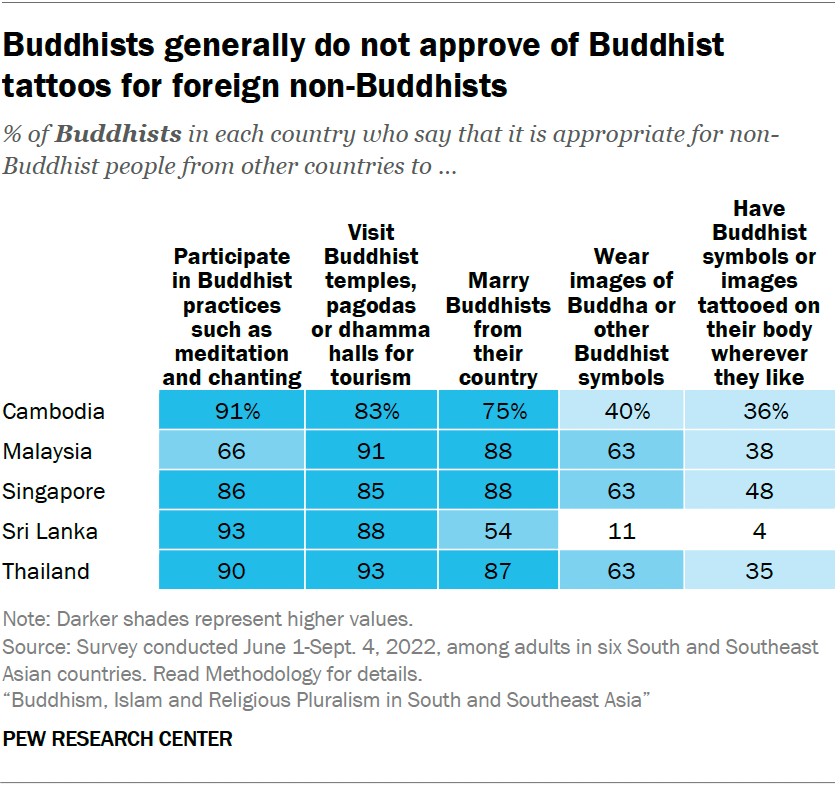 Buddhists generally do not approve of Buddhist tattoos for foreign non-Buddhists
Buddhists generally do not approve of Buddhist tattoos for foreign non-Buddhists
15. What Can Tourists Do to Promote Religious Understanding?
Tourists can promote religious understanding by being respectful of local customs and traditions, engaging in interfaith dialogue, supporting organizations that promote religious tolerance, and educating themselves about the different religions in the region. By demonstrating sensitivity and curiosity, tourists can help foster positive relationships between different communities.
Here are some practical tips for promoting religious understanding:
- Learn About Local Religions: Educate yourself about the history, beliefs, and practices of the different religions in the region.
- Visit Religious Sites Respectfully: Dress modestly, remove your shoes, and avoid loud or disruptive behavior when visiting temples, mosques, or churches.
- Engage in Interfaith Dialogue: Seek opportunities to talk with people from different religious backgrounds and learn about their perspectives.
- Support Interfaith Organizations: Donate to or volunteer with organizations that promote interfaith dialogue and cooperation.
- Be Mindful of Your Language: Avoid using stereotypes or making generalizations about religious groups.
- Respect Local Customs: Be respectful of local customs and traditions, even if they differ from your own.
- Promote Positive Images: Share positive stories and images of religious diversity and harmony on social media.
- Challenge Prejudice: Speak out against prejudice and discrimination whenever you encounter it.
- Lead by Example: Demonstrate respect and understanding in your own interactions with people from different religious backgrounds.
16. How Can SIXT.VN Enhance Your Travel Experience?
SIXT.VN can enhance your travel experience by providing reliable and convenient services tailored to your needs. We offer airport transfers, hotel booking assistance, sightseeing tours, and more, ensuring a seamless and enjoyable trip. Our local expertise and commitment to customer satisfaction make us the perfect partner for exploring Vietnam and beyond.
Here’s how SIXT.VN makes your trip better:
- Airport Transfers: Start your trip stress-free with our reliable airport transfer services.
- Hotel Bookings: Choose from a wide range of hotels to suit your budget and preferences.
- Sightseeing Tours: Discover the best attractions with our guided tours, offering insights into local culture and history.
- Local Expertise: Benefit from our in-depth knowledge of Vietnam and its diverse regions.
- Customer Support: Enjoy peace of mind with our dedicated customer support team available to assist you.
17. What Are Some Common Misconceptions About Religion in Vietnam?
Some common misconceptions about religion in Vietnam include the belief that it is predominantly Buddhist, that all Vietnamese are deeply religious, or that there is no religious diversity. In reality, Vietnam has a rich tapestry of religions, including Buddhism, Christianity, Caodaism, and Hoa Hao, and many Vietnamese practice a mix of folk religions and ancestor worship. Understanding these nuances can enrich your travel experience and foster more meaningful connections with locals.
- Misconception 1: Vietnam is entirely Buddhist.
- Reality: While Buddhism is prominent, Vietnam has a mix of religions including Caodaism, Hoa Hao, Christianity, and folk beliefs.
- Misconception 2: All Vietnamese are deeply religious.
- Reality: Religious observance varies; many blend traditional folk practices with organized religions.
- Misconception 3: There is no religious diversity in Vietnam.
- Reality: Vietnam has a rich religious tapestry, reflecting its complex history and cultural influences.
18. How Can I Show Respect When Visiting Religious Sites in Vietnam?
When visiting religious sites in Vietnam, it is essential to dress modestly, remove your shoes before entering temples or pagodas, avoid loud conversations, and refrain from taking photos during religious ceremonies. It is also polite to ask for permission before taking pictures of monks or other religious figures. By demonstrating respect for local customs, you can show your appreciation for Vietnam’s rich cultural heritage.
- Dress Modestly: Wear clothing that covers your shoulders and knees.
- Remove Shoes: Take off your shoes before entering temples or pagodas.
- Be Quiet: Avoid loud conversations and maintain a respectful demeanor.
- No Photos During Ceremonies: Refrain from taking photos during religious ceremonies.
- Ask Permission: Politely ask for permission before photographing monks or religious figures.
19. What Are Some Unique Religious Festivals in Vietnam?
Vietnam is home to many unique religious festivals, including the Perfume Pagoda Festival, the Vu Lan Festival (also known as Ghost Festival), and the Christmas celebrations in the Christian communities. These festivals offer a glimpse into Vietnam’s diverse spiritual landscape and provide opportunities to witness colorful ceremonies, traditional performances, and heartfelt expressions of faith.
- Perfume Pagoda Festival: A Buddhist pilgrimage featuring boat rides and cave visits.
- Vu Lan Festival (Ghost Festival): A time to honor ancestors with offerings and prayers.
- Christmas Celebrations: Vibrant celebrations in Christian communities, blending local traditions with Christian customs.
20. How Does the Vietnamese Government Approach Religious Freedom?
The Vietnamese government officially recognizes and protects religious freedom, but religious organizations are required to register and operate within the framework of the law. While there have been reports of restrictions on certain religious activities, the government generally allows people to practice their faith freely, as long as it does not threaten national security or social order.
- Official Recognition: The government recognizes and protects religious freedom.
- Legal Framework: Religious organizations must register and operate within the law.
- General Freedom: People are generally free to practice their faith, as long as it does not threaten national security or social order.
FAQ: Local Attitudes Towards Different Religions Coexisting
- How tolerant are Southeast Asian countries of religious diversity? Most are generally tolerant, with Malaysia, Sri Lanka, and Singapore being particularly open.
- Does education level affect religious tolerance? Yes, higher education levels generally correlate with more tolerant views.
- Are there differences in how religions view each other in Southeast Asia? Yes, Hindus and Christians often view other religions more peacefully than Muslims.
- What role does age play in attitudes towards religious diversity? Younger adults are typically more accepting of different religions as neighbors.
- How do Southeast Asians view the compatibility of religions with their culture? Majorities in most countries agree they are compatible, especially in Singapore.
- What are key elements of national identity in Southeast Asia? Order, harmony, and supporting the country are key; nativist elements are also important but less so in Singapore.
- Do Southeast Asians feel their culture is superior? Most do, particularly in Cambodia, Sri Lanka, Malaysia, and Indonesia.
- What are views on violence based on political or religious beliefs? Most believe it is never justified, especially in Cambodia, Sri Lanka, and Singapore.
- What do Muslims and Buddhists see as threats to their religions? Extremists from their own faith and, for Muslims, U.S. influence.
- What do Buddhists consider appropriate for foreign non-Buddhists? Participating in practices and visiting temples is fine; adopting symbols, especially tattoos, is less accepted.
Ready to explore Vietnam’s rich cultural and religious tapestry? Let SIXT.VN be your trusted guide! Contact us today to plan your unforgettable journey:
- Address: 260 Cau Giay, Hanoi, Vietnam
- Hotline/Whatsapp: +84 986 244 358
- Website: SIXT.VN
Conclusion: Embrace the Diversity with SIXT.VN
Understanding local attitudes towards different religions coexisting is crucial for a meaningful and respectful travel experience in Southeast Asia. With SIXT.VN, you can navigate this diverse landscape with ease, knowing you have a reliable partner to help you explore and appreciate the region’s rich cultural and religious heritage. Book your airport transfer, hotel, or tour today and embark on an unforgettable adventure with SIXT.VN!



